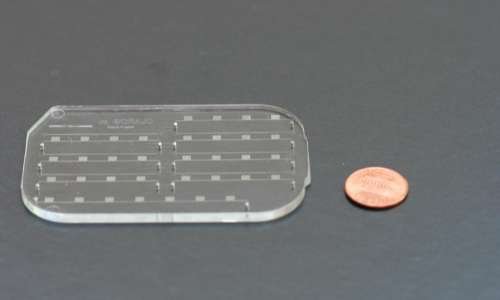
A zoomed photo of fluid moving through a small channel in the microfluidic chip. Credit: Sia Lab/Columbia Engineering and OPKO Health
Some 300,000 people in the U.S. are diagnosed with Lyme disease every year. Caused by Borrelia burgdorferi and transmitted by the bite of infected Ixodes ticks, the disease if left untreated can cause serious neurologic, cardiac, and/or rheumatologic complications.
Current testing for Lyme disease, called the standard 2-tiered approach or the STT, involves running two complex assays (ELISA and western blot) to detect antibodies against the bacterium, and requires experienced personnel in a lab, and a few hours to carry out and interpret. A team led by Sam Sia, professor of biomedical engineering at Columbia Engineering, has developed a rapid microfluidic test that can detect Lyme disease with similar performance as the STT in a much shorter time—15 minutes.
"Our findings are the first to demonstrate that Lyme disease diagnosis can be carried out in a microfluidic format that can provide rapid quantitative results," says Sia, whose lab is focused on using microfluidics to build low-cost, integrated devices for performing sophisticated medical tests, together with developing new treatment modalities based on cell therapy and implantable devices. "This means that our test could easily be used directly in a doctor's office, obviating having to send the samples out to a laboratory that needs at least a couple of hours, if not days, to get test results."
Sia's group worked in collaboration with Maria Gomes-Solecki from Immuno Technologies, which found a combination of three proteins that identified antibodies specific to the B. burgdorferi bacterium in the serum, and OPKO Health, which provided microfluidic cassettes. Their findings were published today in the Journal of Clinical Microbiology.

A microfluidic chip used to test for Lyme disease. Credit: Sia Lab/Columbia Engineering and OPKO Health
New test diagnoses Lyme disease within 15 minutes
Home
Share
Feedback
Add to favorites
Comments
Newsletter
About
Science X profile
Full version
New test diagnoses Lyme disease within 15 minutes
October 11, 2019 , Columbia University School of Engineering and Applied Science
New test diagnoses Lyme disease within 15 minutes
A zoomed photo of fluid moving through a small channel in the microfluidic chip. Credit: Sia Lab/Columbia Engineering and OPKO Health
Some 300,000 people in the U.S. are diagnosed with Lyme disease every year. Caused by Borrelia burgdorferi and transmitted by the bite of infected Ixodes ticks, the disease if left untreated can cause serious neurologic, cardiac, and/or rheumatologic complications.
Current testing for Lyme disease, called the standard 2-tiered approach or the STT, involves running two complex assays (ELISA and western blot) to detect antibodies against the bacterium, and requires experienced personnel in a lab, and a few hours to carry out and interpret. A team led by Sam Sia, professor of biomedical engineering at Columbia Engineering, has developed a rapid microfluidic test that can detect Lyme disease with similar performance as the STT in a much shorter time—15 minutes.
"Our findings are the first to demonstrate that Lyme disease diagnosis can be carried out in a microfluidic format that can provide rapid quantitative results," says Sia, whose lab is focused on using microfluidics to build low-cost, integrated devices for performing sophisticated medical tests, together with developing new treatment modalities based on cell therapy and implantable devices. "This means that our test could easily be used directly in a doctor's office, obviating having to send the samples out to a laboratory that needs at least a couple of hours, if not days, to get test results."
Sia's group worked in collaboration with Maria Gomes-Solecki from Immuno Technologies, which found a combination of three proteins that identified antibodies specific to the B. burgdorferi bacterium in the serum, and OPKO Health, which provided microfluidic cassettes. Their findings were published today in the Journal of Clinical Microbiology.
New test diagnoses Lyme disease within 15 minutes
A microfluidic chip used to test for Lyme disease. Credit: Sia Lab/Columbia Engineering and OPKO Health
The researchers evaluated 142 samples, including patients with early Lyme disease, healthy individuals from areas where Lyme disease is endemic, and those with Lyme arthritis. They first screened a set of known diagnostic Lyme disease biomarkers for their ability to detect Lyme disease infection. They then tested the top three biomarkers using a standard enzyme immunoassay, and then mChip-LD, an advanced microfluidic platform developed by Sam Sia, to test the samples.
When tested against additional samples of serum from people with Lyme disease, the multiplexed set of biomarkers was more sensitive than standard Lyme disease tests, while also exhibiting high specificity. The team found that it was better at picking up signs of Lyme disease infection in early-stage samples—possibly because it was able to detect antibodies that peak in the first weeks after someone is infected with Lyme disease.
When the test was run on Sia's mChip-LD platform, it worked very well, showing strong potential for the development of a point-of-care test for Lyme disease. "While the assay will require more refinement and testing before it can be approved for widespread use as a test for Lyme disease, our results are very exciting," says one of the study's lead authors, Siddarth Arumugam, who is a Ph.D. student in Sia's lab. "It will help so many people if we can develop a single, rapid, multiplexed diagnostic test to identify Lyme disease stage that can be used in doctors' offices."
Sia is the co-founder of Claros Diagnostics, whose underlying microfluidics technology is now being commercialized by OPKO Health and was recently approved by the FDA for testing for prostate cancer. He and Gomes-Solecki are now planning a more thorough clinical validation study to see whether the performance of the Lyme microfluidic platform holds up
Hi! I am a robot. I just upvoted you! I found similar content that readers might be interested in:
https://www.sciencedaily.com/releases/2019/10/191011112246.htm
Downvoting a post can decrease pending rewards and make it less visible. Common reasons:
Submit